[abstract: ] This paper considers the experience of embodiment in current and (possible) future virtual reality applications. A phenomenological perspective is adopted to explore user embodiment in those virtual reality applications that both do and do not include a visual body (re)presentation (virtual body). Embodiment is viewed from the perspective of sensorial immersion, where issues of gender, race, and culture are all implicated. Accounts of “disrupted” bodies (for example, phantom limb and dissociation of the selffrom the body, paralysis, and objectified bodies) are advanced in order to provide a context for understanding the ways in which embodiment in virtual reality environments may be instantiated. The explicit claim that virtual reality is an embodied experience and can facilitate the radical transfiguration of the body and its sensorial architecture is explored and evaluated.
incapable of what?
zeph’s pop culture quiz #21
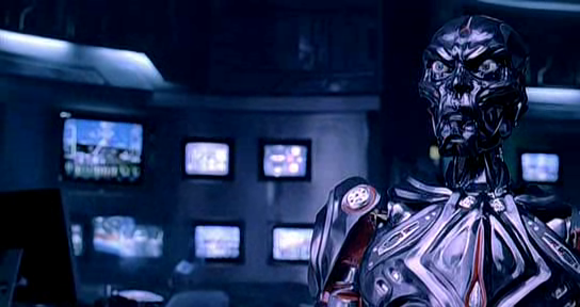
What is he/it incapable of? What can’t he/it do in the scene depicted?
Just leave a comment with your educated guess—you can ask for additional hints, too. [Leaving a comment is easy; just click the ‘Leave a comment’ at the end of the post and fill in the form. If it’s the first time you post a comment, it will be held for moderation. But I am constantly checking, and once I’ve approved a comment, your next ones won’t be held, but published immediately by the system.]
UPDATE and solution (28 March 2012):
Frankly, I do not have the faintest idea of how he could know that, but Alexander Rabitsch ↵correctly stated that the movie is ↑Endhiran [aka Enthiran, original title: எந்திரன்] (Shankar 2010). In India there are two large movie industries; the Hindi-language one bases in Mumbai, formerly Bombay (‘Bollywood’), and the Tamil-language one, based in Chennai, formerly Madras. Endhiran, meaning ‘robot,’ is a 2010 Tamil-movie starring ↑Aishwarya Rai. It’s pure cyberpunk, and at the same time a pure Indian movie—get a taste of it at ↑the official website.
And here is the solution to the question. The evil scientist makes a test of his creation, the mean looking robot. He activates him and gives him commands:
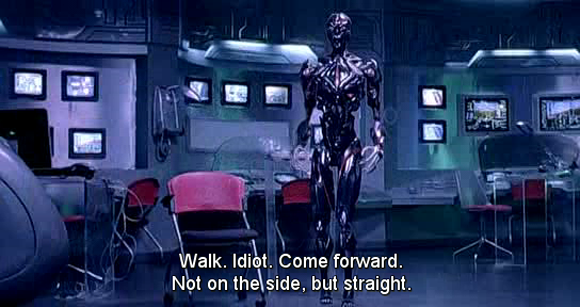
But the robot acts clumsy, even hits a table, and the evil scientist exclaims: ‘Shit!’ The machine takes that for a command and replies:
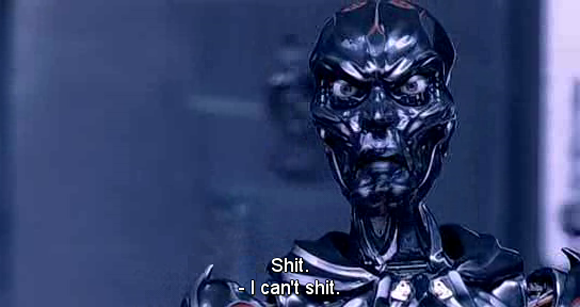
The clumsiness goes on and finally the robot, after firing a gun, falls to the floor. His creator is upset and makes clear that he doesn’t think much of him:
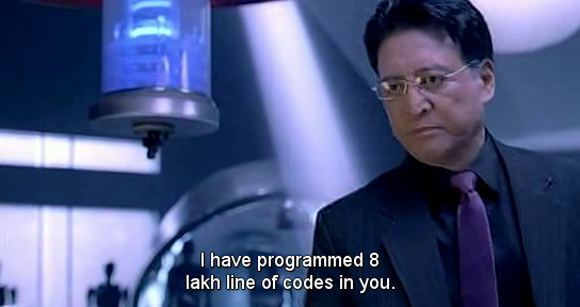
Which is returned by quite a tell-tale stare …
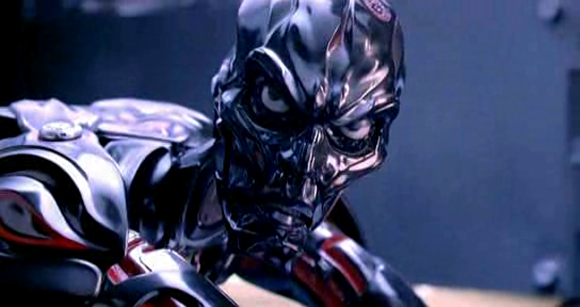
turing’s cathedral

Here’s the official synopsis of historian of science ↑George Dyson‘s latest book ‘Turing’s Cathedral’ (2012):
“It is possible to invent a single machine which can be used to compute any computable sequence,” twenty-four-year-old Alan Turing announced in 1936. In Turing’s Cathedral, George Dyson focuses on a small group of men and women, led by John von Neumann at the Institute for Advanced Study in Princeton, New Jersey, who built one of the first computers to realize Alan Turing’s vision of a Universal Machine. Their work would break the distinction between numbers that mean things and numbers that do things—and our universe would never be the same.
Using five kilobytes of memory (the amount allocated to displaying the cursor on a computer desktop of today), they achieved unprecedented success in both weather prediction and nuclear weapons design, while tackling, in their spare time, problems ranging from the evolution of viruses to the evolution of stars.
Dyson’s account, both historic and prophetic, sheds important new light on how the digital universe exploded in the aftermath of World War II. The proliferation of both codes and machines was paralleled by two historic developments: the decoding of self-replicating sequences in biology and the invention of the hydrogen bomb. It’s no coincidence that the most destructive and the most constructive of human inventions appeared at exactly the same time.
How did code take over the world? In retracing how Alan Turing’s one-dimensional model became John von Neumann’s two-dimensional implementation, Turing’s Cathedral offers a series of provocative suggestions as to where the digital universe, now fully three-dimensional, may be heading next.
For complementary reading I wholeheartedly recommend Jack Copeland’s ‘Colossus: The Secrets of Bletchley Park’s Codebreaking Computers’ (2006)!
pfaffenberger on society
Today, most sociologists accept that communities arise, not necessarily from face-to-face interaction, but rather from shared meanings. Because they are capable of promulgating shared meanings on an unprecedented scale, new communication and media technologies (including newspapers, motion pictures, radio, television, and computer-based communications) are capable of creating communities that vastly transcend the limits of face-to-face interaction. (Pfaffenberger 2008: 651)
Durkheim’s understanding of society was informed by likening its constituent elements to an advanced, highly differentiated organism. Scientific and technological advances in the twentieth century made new metaphors available to sociological theorists. Drawing on the emerging fields of cybernetics and systems theory, in the 1930s American sociologist Talcott Parsons (1902–1979) depicted the interdependence of social phenomena in terms of a hierarchy of intercoupled systems and subsystems. Niklas Luhmann (1927–1998), a student of Parsons, drawing on chaos theory, depicted society as a complex, self-organizing system. (Pfaffenberger 2008: 651)
anteworld
strange apparition
As I’ve ↵said before, I am totally opposed to the idea of using a sealed off portion of Gotham as a prison cum asylum. So I decided to give a press conference at Arkham City’s entrance area. Despite the press and TV news cameras, including anchorwoman Vicky Vale, being present, the mercenaries of Tyger Security grab me, knock me unconscious, and drag me away.

Next thing I remember is being tied to a chair, getting slapped, fainting again and again, the occurences coming to me as memory flashbacks. It’s ↵Hugo Strange standing in front of me. On his orders the Tyger mercenaries dragged me here and tied me to the chair. Everything in broad daylight, in front of news cameras. Testimony to mayor Sharp indeed having transformed Gotham City into a police state. Fittingly enough he made Professor Strange the head of Arkham City—of all people …
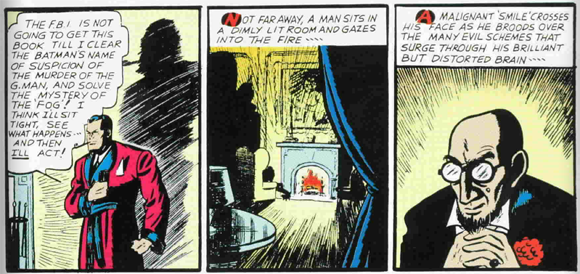
Strange is one of the Batman’s oldest acquaintances. The first supervillain and recurring foe of the dark knight was Doctor Death (Fox & Kane 1939), the second the Monk (Fox, Kane & Moldoff 1939), and the third Professor Hugo Strange (Finger, Kane & Robinson 1940: 3 [see above])—he’s older than the Joker.
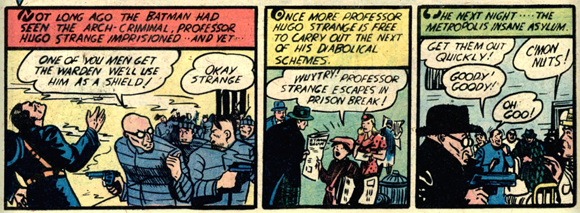
When Strange appears for the second time (Finger, Kane & Hoolahan 1940: 20 [see above]), he frees inmates of an asylum … to turn them into monsters by a substance, a ‘growth hormone,’ he has invented. Well, with all the ‘roids called ‘Titan’ let loose in Arkham Asylum last time, I can imagine what I’ll be up against with Strange now being warden of Arkham City.
While battling Strange and his mutant giants, the Batman knocks the Professor out of the window of his hideout, high on a cliff above the sea: ‘The powerful blow sends Strange out—to fall to murky waters below …’
Looking down on the sea the Batman ponders: ‘I wonder if this really is the end of Professor Hugo Strange???’ (Finger, Kane & Hoolahan 1940: 26) Well, for 37 years it seemed to have been his end. Then ↵he returned and found out that Bruce Wayne is Batman (Englehart et al. 1977: 17):
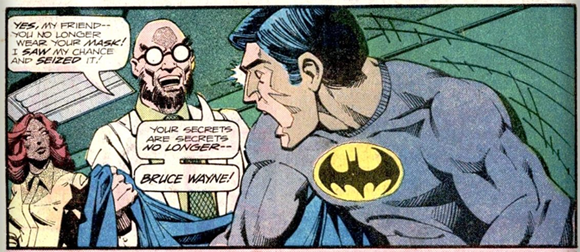
While I am bound on that chair, Strange slaps it into my face that he still knows that I, Bruce Wayne, am Batman. Then he orders his mercs to bring Bruce Wayne into Arkham City …
lego serving science
I especially like this Google Science Fair 2012 video, because it shows how much makeshift and creative improvisation takes place in laboratory work—quite to the contrary of the usual renditions of hight-tech labs in movies. And I of course do like it, because Lego is used. Another instance of Lego serving science is a recent publicity stunt: The personnel of the German research-station ↑Neumayer III in antarctica are ↑recreating their station out of 7000 Lego pieces [in German]. Seemingly as a kind of group therapy to overcome the boredom during the antarctic winter :-)
einstein archives online
who is inside?
zeph’s pop culture quiz #20
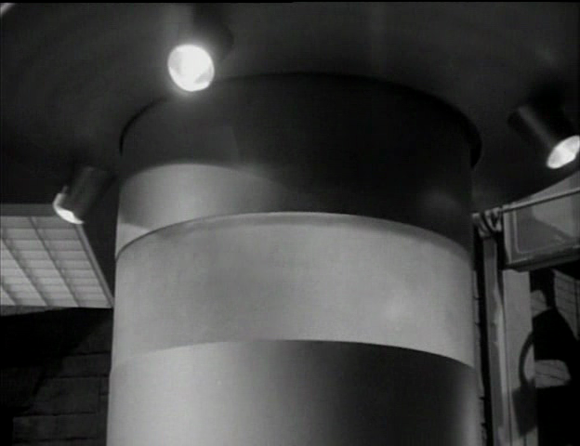
Who is inside the tube?
Just leave a comment with your educated guess—you can ask for additional hints, too. [Leaving a comment is easy; just click the ‘Leave a comment’ at the end of the post and fill in the form. If it’s the first time you post a comment, it will be held for moderation. But I am constantly checking, and once I’ve approved a comment, your next ones won’t be held, but published immediately by the system.]
UPDATE and solution (26 March 2012):
That’s a first, nobody solved the riddle. And I thought you scifi buffs would recognize this classic right away:
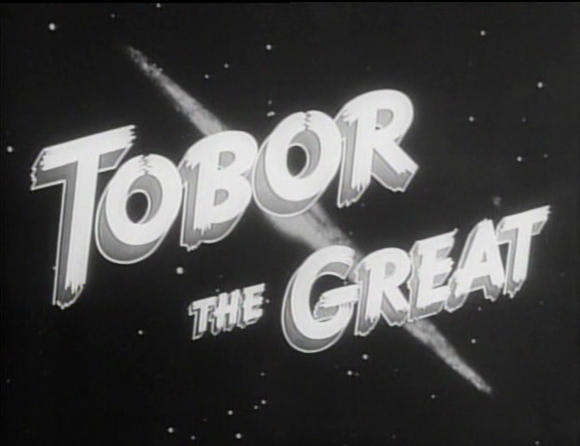
And here is Tobor unveiled, while the tube containing him sinks into the ground
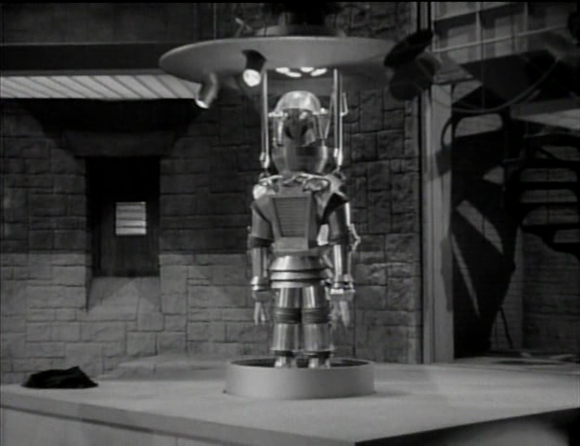
entering arkham city
After a careful clean reinstall finally I am able to immerse into the ↑Batman‘s mythic universe. A bunch of goons inside a slightly decaying 19th century room. By the masks they wear you can tell that they are ↑Two-Face‘s henchmen. He makes them resemble himself. Chattering away they search the room and find a wall-safe hidden behind a painting. That’s the moment when they get disturbed from above. Fear of the Batman immediately fills them.
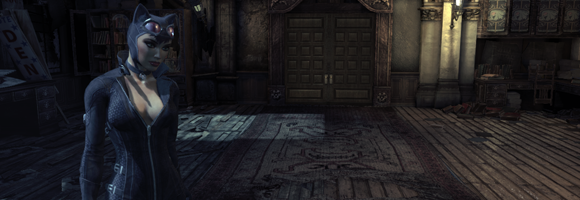
But it’s not the dark knight’s skin I get to slip into first—it’s ↑Catwoman‘s instead. Her appearance soothed me, I have to confess. Despite the hassle with the installation of ‘↑Batman: Arkham City‘ (Rocksteady Studios 2011), I made my peace with the game—until the still existant bug bites and I am going to lose all my savegames, that is.
As far as I can tell the fighting system is the same as in ‘↑Batman: Arkham Asylum‘ (Rocksteady Studios 2009) and quite gracefully Catwoman knocks the whole bunch unconscious. They are no match to Selina Kyle. Them being quiet now leaves me undisturbed to try out Catwoman’s movement. But there’s not much to discover in the room. When I try to open the door my own voice reminds me from off-camera that can’t leave before I got what I came for. So I open up the safe and discover a tiny flash drive. Once inserted into my smartphone it gives me the floorplan of a house on Park Row. Next thing I know is a heavy .45 calibre automatic against my temple.
Fade to black.
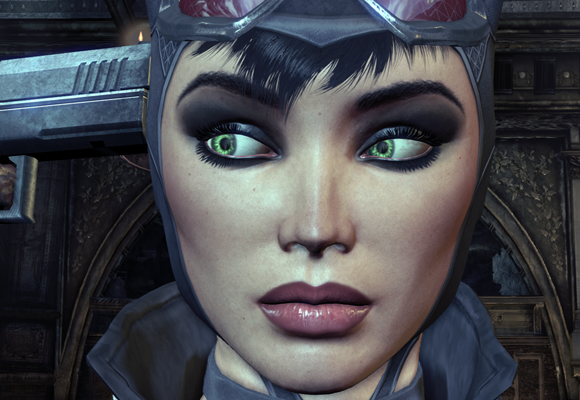
It’s been 18 months ago that I could stop and revert the Joker’s takeover of Arkham Asylum on Arkham Island. Ironically enough the publicity of my success led to Quincy Sharp, back then Arkham’s warden, becoming mayor of Gotham City. Now he was in the position to make his plans a reality. In his secret office at Arkham Asylum I had found Quincy Sharp’s Gotham City proposal:
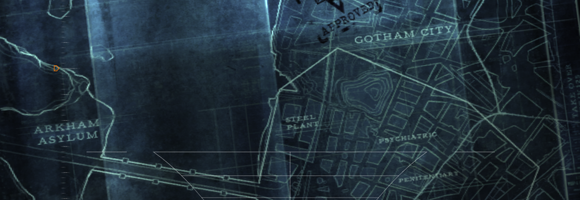
He bought a vast portion of Gotham’s decaying, slumified quarter and sealed it off. The Berlin Wall pales against this fortification. Next he closed both Arkham Asylum and the ↑Blackgate Penitentiary, relocating all inmates to the sealed-off terrain—Arkham City. Under Sharp Gotham develops into a totalitarian police state. Everybody with the slightest criminal record whatsoever is sent to Arkham City. Inside the prisoners can do whatever they fancy, as long as they do not attempt to scale the wall. To ensure that the lot really remains within Arkham City, the whole area is guarded by private military firm, Tyger Security.
Naturally I, the philanthropist billionaire Bruce Wayne, am strongly opposed to the whole idea of Arkham City …


